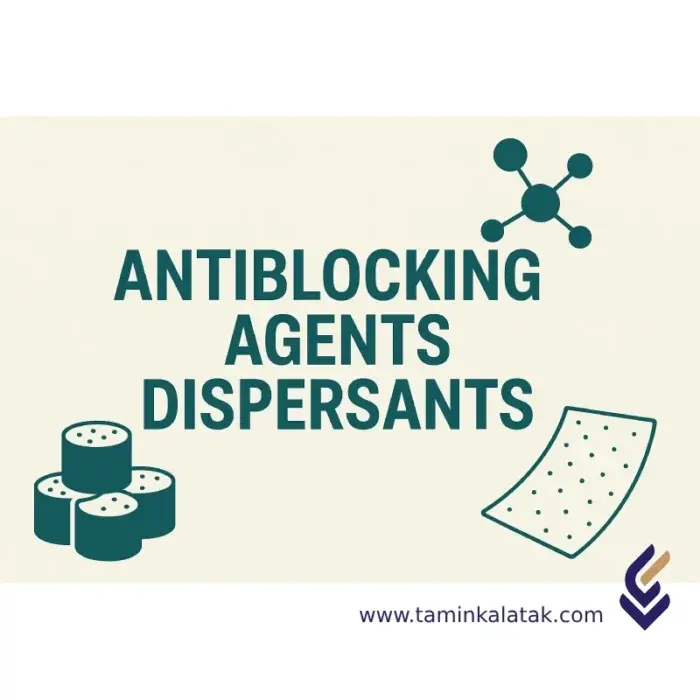Polymers are made up of very large molecules made up of many repeating units called monomers, which ultimately form this long polymer chain
AntiBlocking Agents & Dispersants
In the world of polymeric materials, surface quality and processing performance hold exceptional importance. As you may already know, one of the most crucial additives used to enhance these properties is antiblocking agents and dispersants. These compounds play a key role in preventing plastic film surfaces from sticking together and ensuring the uniform dispersion of pigments and other additives.
A clear understanding of their structure, applications, advantages, and limitations is essential for formulators, engineers, and manufacturers alike.
Chemical Structure of Antiblocking Agents
Antiblocking agents are generally composed of silicas (SiO₂), talc, kaolin, special polyamides, and occasionally polyethylene waxes.
In dispersants, non-ionic, amphoteric, or aliphatic surfactants are often used depending on the formulation and end-use requirements.
Common Types and Market Compositions
| Additive Type | Main Chemical Composition | Common Application |
|---|---|---|
| Silica-based Antiblocking Agent | Silicon Dioxide (SiO₂) | PE and PP Films |
| Non-ionic Dispersant | Polyacrylate or Copolymers | Water-based paints, printing inks |
Key Characteristics
Antiblocking and dispersing agents exhibit a unique set of physical, chemical, and functional properties, making them indispensable across industries such as plastic film production, paints, inks, and coatings.
Physical Properties
-
Fine particle size (typically 1–10 microns)
-
High hardness to generate micro-surface texture
-
Excellent dispersibility and process uniformity
Chemical Properties
-
High thermal stability
-
Compatibility with a broad range of polymers
-
Non-reactive with most resin systems
Environmental Stability
Next-generation biodegradable antiblocking agents are designed to meet growing environmental sustainability demands.
Applications
Plastic Films
Used in PE, PP, and PVC films to prevent surface adhesion, facilitating easy winding, unwinding, and efficient handling during production and end use.
Paints and Printing Inks
Dispersants promote even pigment distribution, significantly enhancing color uniformity and final finish quality.
Packaging and Pharmaceutical Industries
Applied to reduce surface friction in tablet packaging or pharmaceutical coatings, ensuring smoother production and handling.
Advantages
-
Improves production efficiency
-
Reduces surface adhesion in thin films
-
Enhances color brightness and clarity in water-based systems
-
Improves printing performance and color consistency
-
Saves time and energy in industrial processes
Disadvantages
-
Some antiblocking agents may reduce film transparency
-
Possible incompatibility with certain masterbatches
-
May require higher dosage levels, increasing cost
-
Can negatively affect slip properties (COF) in some cases
Conclusion: The Role of Antiblocking Agents and Dispersants
Antiblocking agents and dispersants play a vital role in optimizing the performance and quality of polymeric and chemical products.
By improving particle distribution and preventing surface adhesion, they not only increase manufacturing efficiency but also enhance the final product’s visual and mechanical properties.
From an industrial perspective, selecting the right additive must be based on the specific requirements of each process. Compounds with high thermal stability, polymer compatibility, and minimal impact on product transparency are considered the most effective choices.
Moreover, balancing economic factors with desired quality outcomes—such as avoiding excessive cost or haze—remains crucial for maintaining efficient and competitive production.
Applications
| Applications | , , , |
|---|
Antiblocking agents & dispersants
| Products | Grid | Melt Flow Index (MFI) (g/10 min) | Density (g/mm³) | Process method | Applications |
|---|---|---|---|---|---|
| AB-1000 | Heat resistant | 9,00 | 95,00 | Thermal lamination | Industrial packaging, adhesive-resistant applications |
| ABX-300 | Film standard | 35,00 | 92,00 | Film extrusion | Food packaging, stretch films |
| DXP-412 | With high transparency | 18,00 | 89,00 | Injection molding | Transparent containers, pharmaceutical caps |
| ECO-BLOCK | Bio-based | 21,00 | 91,00 | Thin coatings | Pharmaceutical and biodegradable industries |







